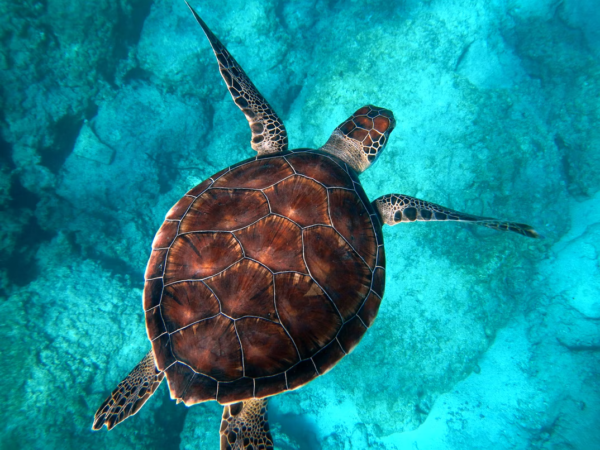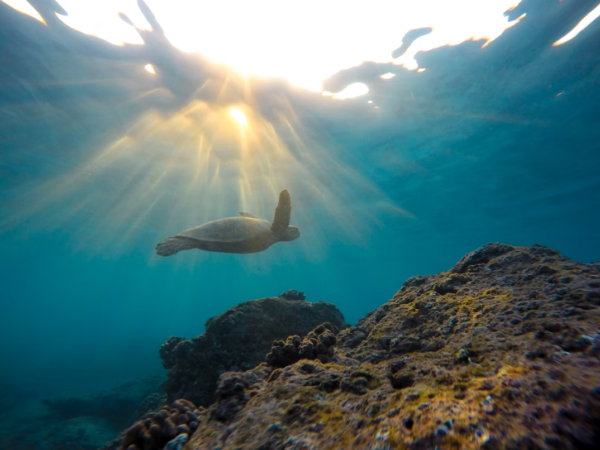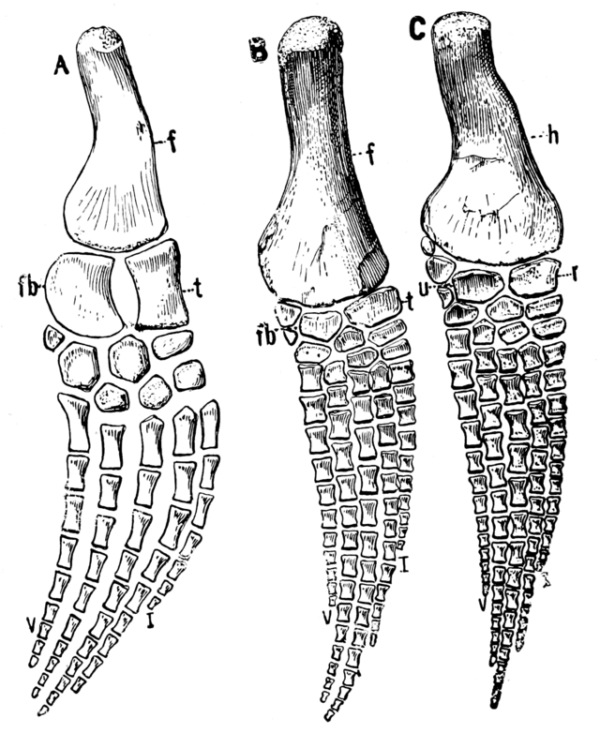We are all familiar with turtles, reptiles belonging to the order Testudines. There are over 360 species of turtles found around the world. This includes tortoises and terrapins as well. They are cold-blooded and lay eggs. They also have scales all over their skin and a bony shell. And like any other reptile, they mostly spend a lot of their time in or around water.
Due to their heavy shells, turtles can’t move very quickly on land. But they are relatively fast swimmers, with speeds of about 19 miles per hour. This might make you wonder whether turtles have fins to help them swim underwater. Let us find out the answer to this question!
Table of Contents
Do Turtles Have Fins?
Fins are essential for most aquatic animals, such as fish and mammals. These fins help produce thrust while swimming underwater. You can think of them in much the same way as an airplane’s wings providing it with lift while flying.
They are also valuable tools for steering and turning quickly. Fins also give some stability to the animal’s posture. This makes fins an essential requirement for moving and surviving in aquatic systems.

This begs the question: do turtles also have fins? The short answer is no. Turtles don’t have fins. Instead, they have different forms of limbs. The exact design of their limbs depends on the habitat they are most commonly found in.
The turtle species which spend most of their lives swimming have specialized limbs. They are usually one of two kinds: either webbed feet or flippers.
Freshwater turtle species generally have long toes with webbing on their feet. This means a thin membrane or tissue usually connects the toes on their limbs. This increases the surface area of the limbs. It allows the turtle to generate enough force to thrust itself around effectively.
Turtles swim by paddling all four of their feet in sync. They bring their fore and hind legs in and throw them out simultaneously in a well-coordinated fashion. You can visualize their movement as very similar to how oars move a boat forward. This helps the turtle in maintaining a specific direction as well.
Webbed feet also allow species like mud turtles to walk on the bottom of the seafloor simply. Heavier turtles prefer this mode of locomotion over swimming since it requires less energy.
On the other hand, sea turtles have modified flippers for swimming. In particular, their front legs are long flippers. Their hind legs are shorter and heavier, hanging behind them like rudders. This means the front legs do most of the work when the turtle is swimming. The hind legs primarily help in stabilizing their motion.
Sea turtles also have other specializations. For instance, they have a streamlined shell design. Their sharp and compact shell reduces friction and drags on their body underwater. This contrasts with a tortoise’s shell, which is larger and rougher.
Unlike most other reptiles, turtles also feature shorter, reduced tails. Their tails have more girth than length, and sea turtles use it for balance. When these features are coupled with flippers, their swimming speeds increase drastically. They become almost on par with other types of fish!
Difference Between Flippers And Fins
Both fins and flippers serve the same purpose of helping aquatic animals swim. They both do the maneuver, generate force and help maintain balance while swimming. Their objectives are so similar that the word ‘flippers’ is sometimes used synonymously with ‘fins.’ Despite being so similar, there are some critical differences between them.
Fins do not have an actual skeletal structure. This means they do not contain any bony parts. Instead, they primarily consist of cartilage.
On the other hand, a flipper has a proper bone structure and joints, tendons, and cartilage. A flipper on a turtle heavily resembles a human’s arms, from the shoulders down to the fingers!
This is because flippers are modified limbs. Thus, flippers and arms are homologous structures. They share the exact evolutionary origin but are used for different functions. Flippers are also found on aquatic mammals like whales, penguins, and seals.
Almost all species of fish have fins. These fins broadly fall into two categories – dorsal and pectoral fins. The dorsal fin is an unpaired fin found on the back of the fish. Though some species might have two or three dorsal fins, these are arranged in a single line. These fins keep the fish’s body upright at all times. Some fish also have tail fins for this reason.
On the other hand, pectoral fins are paired. They are the primary mechanism used by fish for swimming around. Fins and flippers are thus analogous structures. Even though they are used for the same function, they do not share the exact origin. They are believed to have evolved independently.
Do All Turtles Have Flippers?
As we already discussed, some species of turtles do not have flippers. Instead, they make use of webbed feet. This is usually the case for freshwater turtles and pond turtles. But there are even more varieties of limbs found in other species.

Tortoises, or box turtles, spend a lot of time in terrestrial environments. So they have evolved columnar legs instead. Their feet generally contain five toes. This helps them walk efficiently on land.
Their legs are also thick and short, which is why they are called elephantine. Most interestingly, the gopher tortoise has even more highly specialized feet. Gopher tortoises are known for their burrowing abilities. So they have flattened front legs that help them in digging!
Why Do Turtles Have Webbed Feet?
Mostly all species of aquatic turtles have webbed feet. This is because turtles tend to spend time inside water and on land. Webbings help the turtle propel itself forward while swimming. This feat cannot be achieved with simple, unwebbed feet.
On the other hand, the presence of toes means they can still navigate efficiently on land without losing their ability to swim. Thus webbed feet help to increase the effective hunting area for a turtle. They can easily catch swimming prey such as fish. They are also able to forage for food on land.
Some species of turtles can even use their webbed feet to climb trees and feed on insects! Turtles with webbed feet can do all this while also escaping from any potential predators. This is why webbed feet are a significant evolutionary advantage.
Why Do Sea Turtles Have Flippers?
Sea turtles are the only type of turtles with true flippers instead of webbed feet. But why is that so? Unlike other species of turtles, sea turtles derive most of their sustenance only from the sea.
They only come on land to lay eggs before returning to the sea. Thus, they can afford to lose their ability to walk fast on land if that means they can gain speed while in water. This increases their chance of catching prey and running away from predators. It is a boon for their survival.
Thus, strong flippers allow sea turtles to foray deeper for food. They are also able to cover long distances swiftly.
On the other hand, their body plan no longer allows them to retract their limbs inside their body. This means they can’t use their shell for active protection. This is the only significant disadvantage.
Are They Good With Their Flippers?
Sea turtles are adept at using their flippers for locomotion. The Leatherback Sea Turtle is the largest turtle species on the planet. But it is also surprisingly the fastest! It can achieve speeds of up to 21 miles per hour. This shows that even heavyweight turtles aren’t bogged down by their weight when they swim using flippers.

While swimming, sea turtles flap their front limbs in an up and down motion. This movement makes a distinct pattern resembling the figure ‘8’. Only Leatherbacks show different behavior. They pull their flippers back and down instead of back and up. This helps create lift over their flippers which pulls them forward. Sea turtles hold their hind legs in place to act like steering wheels.
But apart from the ease of finding food, flippers help sea turtles in many other situations. For instance, the female turtle has to go out to the surface to lay eggs. The female uses its flippers to haul itself over to the shore. It is a crucial behavior shown by all species of turtles. Leatherback Sea Turtles swim more than 7000 miles just to reach the beach in time for the egg-laying season!
Most species, however, simply lay their eggs and return to the sea. They don’t provide parental care to the baby turtles. To protect their eggs from predators, the turtles thus have to bury them in the soil. First, the females find a suitable location to lay eggs. They then use their front flippers to clear sand and other debris away from the place.
Eventually, they can form a body pit to lie in while nesting. Their hind flippers then help them dig about 15 inch-deep egg chambers. The entire process happens very quickly and effectively. The flippers act like spades, and the females collect and deposit sand to one side as they dig.
After laying eggs, the female crawls out of the nest after they’re done. She uses her hind flippers to pack the chamber up with sand again. Finally, she swipes some dirt on it using her fore flippers. A female may repeat this two to three times, creating several pits. After having finished the entire process, she starts moving back to sea.
Sea turtles also use their flippers for hunting. Flippers are usually very long and thick. Some species use it to their advantage by striking prey with their flippers. This hit is generally strong enough to deal damage to the prey. It is very effective in stunning and incapacitating them.
Alternatively, sea turtles also throw smaller fish out of the water and into the air to achieve the same effect. This activity is known as tossing. Once the prey has stopped moving, it becomes easier to devour.
However, sometimes it is unable to hit its prey effectively. In this case, the turtle may instead choose to just hold the prey down with its flippers while it feeds. Sea turtles uniquely use their flippers for more formidable prey, such as snails and mollusks.
They cut their prey down into smaller pieces which are easier to feed on. They pull at, smash, and sometimes even karate chop the prey to break it into chunks! Some individuals have been seen using this process to remove the tendrils of a jellyfish before eating it.
Even foraging for plants and sponges on the seafloor requires flippers. Sea turtles use their limbs to anchor themselves to the ground while pulling the plants out and chewing on them. They also use the flippers to weed out prey hiding inside crevices. Some use their powerful beaks and flippers as levers for this purpose. This has mainly been documented in the Hawksbills turtles.

However, researchers still aren’t sure how sea turtles learn this behavior. Scientists aren’t sure where these turtles go for the first few years of their life. The years following a turtle hatching and making its way out to the sea are the ‘lost years. It is believed the baby turtles simply surf the sea currents and feed on any prey that comes their way.
But they lack parents who can teach them how to hunt using their flippers. It is not entirely known where they learn it from. One proposed reason is their incredibly long lifespans. In the wild, sea turtles can survive for more than 50 years. Thus their behavior might just be a result of extensive trial and error. But it is sufficient to say that sea turtles are great at using their flippers in versatile ways.
Anatomy Of A Turtle’s Flipper

Sea turtles have unique anatomy in the animal kingdom. Sea turtles evolved in the Cretaceous period. They developed many of their fundamental traits during the early years of their evolution. They have both an internal and an external skeleton.
The external skeleton consists of a bony shell and protects predators. The internal skeleton supports the turtle’s muscles in the same way that ours does.
The flipper of a sea turtle is part of its internal skeleton. They are sensitive to touch. The fore and hind limbs of the turtle contain approximately the same kind of bones as found in a human’s limbs. This design includes five digits!
The long digits of their limbs got fused together over years of evolution to create the flipper. These bones are stiffened and made more robust by fibrous connective tissue. The toe bones are incredibly long and rigid, especially front flippers. The front flippers need to take the most momentum while swimming. The hind limbs are generally smaller and more flexible.
Sea turtles usually have visible claws at the end of their flippers. Leatherbacks have this feature completely missing. Hawksbills and loggerhead turtles have two feet on each flipper. All of the remaining species have a single claw on the edge of their flippers.
Males generally have a more pronounced foot on their forelimbs. It is longer and more curved than females.
The males use their claws to hold on to the female’s shell during the mating process.
Conclusion
So, as we’ve seen, turtles don’t need fins to make their way around the sea. Instead, they have evolved to develop different limb systems over millions of years.
Terrestrial box turtles and tortoises have elephant-like feet with five digits. Aquatic turtles have instead opted for changes in webbed feet and flippers. Sea turtles are the only group of turtles with true flippers. They flap their front flippers around to swim. Their hind flippers are used for steering.
Sea turtles can achieve swimming speeds of up to 21 miles per hour. Flippers not only provide efficient swimming abilities but also help in other situations. Turtles hunt prey and forage food using their flippers. They also use their flippers to dig egg chambers. All in all, turtles are fascinating animals with really unique limbs!
